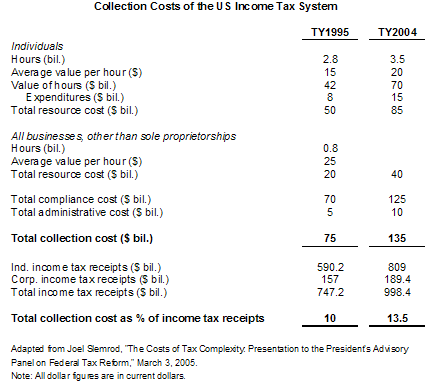Congress Begins to Consider Ways to Simplify the Tax Code
Tax simplification is climbing the domestic priority list. It represents either a shift away from or a complement to the Social Security drive (I suspect that the former applies, but opinion varies). It also has a chance to garner bipartisan support, if Greg Anrig’s post is any indication, though Republicans and Democrats obviously differ on the details.
But it’s a major issue, as this Washington Post report makes clear (emphasis added):
Attention Shifts Toward Simplification of Tax Code
[Y]esterday’s hearing made it clear how difficult simplifying the tax code will be. Five economists, conservative and liberal, laid out the problems with a tax code that one of them, Joel B. Slemrod of the University of Michigan, said costs $125 billion and 3.2 billion hours a year to comply with. They pleaded for dramatic changes that would strip out targeted tax incentives, bewildering tax rate changes and quirks that distort economic behavior.
Slemrod breaks the numbers down further in his presentation to the President’s Advisory Panel on Federal Tax Reform:

And, of course, these are just the accounting costs. A comprehensive economic cost estimate would also consider how the current tax structure affects individuals’ work effort, risk assumption, and other such factors that are admittedly difficult to calculate but nonetheless exist. So the total is even higher than Slemrod’s estimate.
For additional background information, see Hal Varian’s recent New York Times article on Toward Fundamental Tax Reform, a collection of papers released by the American Enterprise Institute.






I know!
Line 1: What is your gross income?
Line 2: Multiply Line 1 by 0.7 and remit.
Simple. :>
Simplify…the key word and a very worthy aim.
Simplify means quicker, easier, less error prone and more satisifactory. Better design means to achieve a function result with clarity, logical process and non-confusing verification.
In Canada, one may make a tax return by telephone if earnings and deductions are fairly straight forward. The process is a matter of listing the key figures, providing security answers and noting a reference number that verifies a return has been filed.
The phone filing method is great because it saves time, paper and postage and mutiple handling.
I wish designers would aim for more simplicity in cell phones and consumer electronics. Two inch thick documentation for software usually means the designer was a compiler of features and had no idea of good design. To simplify and streamline is demanding but very worthwhile.
A program like Print Master has wide popularity because it is a pleasure to use for making a variety of greetings and business cards. Children can use it with satisfying results. This is one measure of good design.
================================
Still on good design; I want to compliment this blogsite. Small Dead Animals is a blogsite in Canada enjoying great success. I entered the name in Answers.com and found
OTB. OTB gave good wishes to Kate of SDAnimals December 3rd/2003 on the start of her blog. My thought was, no wonder Kate is doing so well with SDA. 73s TonyGuitar
I wonder what they’ll come up with next. Historically (as in the last actual 50 year period), income taxes have averaged 18.4% of GDP. Every time we have crossed the 19%/GDP level, the economy has tipped into a recession (for those of you who want to look this up thru the CBO or GAO those years were 1969, 1981, and the 1998-2001 period) and stayed there until tax rates were lowered below the 19% threshold.
Today we are just a tad below 18.4%/GDP.
Now here’s a quick math lesson. If we throw out the military, homeland defense, transportation, commerce, EPA, interior, and FDA – effectively getting rid of everything but federal entitlement program spending, we need to raise the tax rates to approximately 20.4% of GDP and sustain them for the next 50 years to float the proverbial ship of state.
That’s right. The income-tax revenue generation model is no longer workable (from a purely mathematical viewpoint – unfortunately for the pinhead politicans inside the Beltway, 2+2=4, not 109).
I wonder how much of our money and our future they are going to continue to waste before they admit this revenue model doesn’t work and we go on to something that will work – like an investment-income revenue generation model.
This reminds me of that old Fram oil filter commercial – sooner or later, you’re going to come and see me.